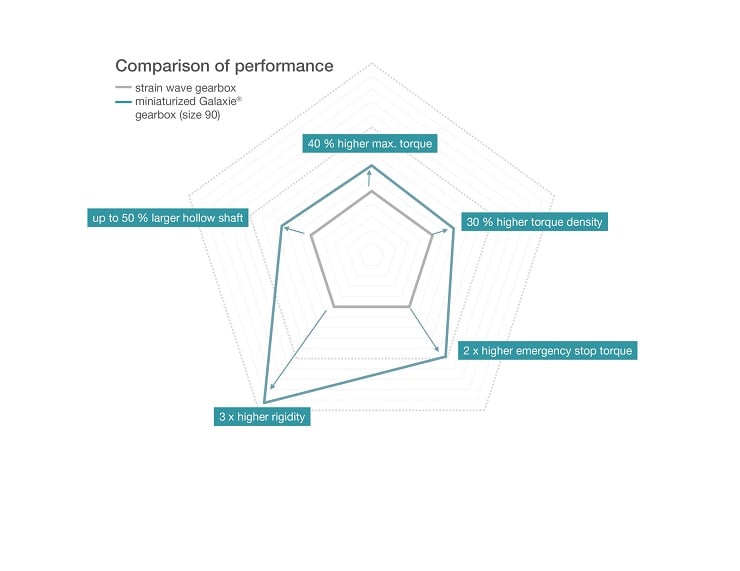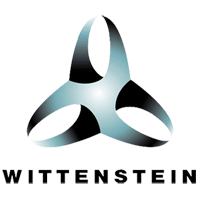
Replacing something relatively proven with something absolutely better – in robotics, this is now a reality thanks to WITTENSTEIN’s new Galaxie® gearbox.
Packaged in compact, standard sizes, a new transmission technology delivers significantly superior performance compared to strain wave gearboxes in terms of torsional rigidity, torque density, overload capacity in emergency stop situations and zero backlash. The new gearbox moreover has an extremely large hollow shaft diameter. The bottom line is a set of characteristics that are perfect for applications in medical and precision robotics, semiconductor and wafer handling systems or high-end machine tools.

The new Galaxie® gearbox is compatible with strain wave gearboxes from the point of view of size, yet it offers significantly better performance with regard to all essential relevant parameters. A brief comparison of the technical data confirms this: the miniaturized Galaxie®, which is currently available in 90 mm and 110 mm sizes, provides up to 30 % higher torque density, three times better torsional rigidity, double the emergency stop torque, true zero backlash throughout its entire lifetime and an up to 50 % larger hollow shaft diameter. These dimensions open up opportunities bordering on revolutionary for robot designers.
Switch from radial to axial motion control
Galaxie® is a brand with a commitment – in other words, no compromises when it comes to the basic function principle as well as high precision and performance. However, in order to deliver equally on this claim in smaller, market-compatible sizes, it was necessary to switch from radial motion control of power transmission to axial. In the new Galaxie® gearbox, the single teeth in the tooth carrier, which are arranged in a gear ring, are axially driven by a polygonal disc with two high points into the facegear with special helical crown gearing, similar to a screwing movement. This kinematic design is responsible for the compact outer dimensions of the new Galaxie® in standard sizes – as well as its ability to achieve up to 40% higher maximum acceleration torques, namely 150 Nm and 250 Nm, compared to strain wave gearboxes. Another highlight of the new kinematics is the true zero backlash in combination with high torsional rigidity.

Best-in-class rigidity confirmed
In a comparative test, the miniaturized Galaxie® outperforms the strain wave gearboxes typically on offer in the market with three times better rigidity – over the whole torque range. On the one hand, this is because – in contrast to strain wave gearboxes with linear contact – almost complete surface contact is possible when the crown tooth flanks of the miniaturized Galaxie® are in mesh. On the other hand, the movement of the polygonal disc when these teeth are in mesh means the majority of them constantly contribute to torque transmission and torsional rigidity. The crown tooth concept also has another advantage: it allows the new Galaxie® to achieve ratios of i=60/61 and in the future even higher – which is a key performance requirement in robotic applications.
Miniaturized Galaxie® optimizes a robot’s resonance behaviour
To reduce oscillation and vibration, the robot axis design is generally stiffness-based. The individual axis resonance frequencies are determined for this purpose from the application’s mass moment of inertia and the rigidity of the gearbox. The three times better rigidity of the new Galaxie® gearbox has the effect of doubling the resonance frequency and also creates potential for downsizing. In practice, the new Galaxie® thus “over-performs” with respect to stiffness-based frequency recommendations, for example for the swivel and positioning axes of medical robots.

More performance or less footprint – now you can have both
The miniaturized Galaxie® also sets benchmarks in relation to power density and overload capacity. In the 90 millimeter size – which is typical with gearbox applications in robotics – it achieves a maximum acceleration torque of 150 Nm, in other words 40% more than strain wave gearboxes with the same footprint. This extra torque density can pave the way for two structural and design options. First, more power can be generated without any increase in footprint by replacing a strain wave gearbox one to one with a miniaturized Galaxie®. Second, it is possible to downsize from a larger and heavier strain wave gearbox to a smaller, lighter and more compact Galaxie® without any loss of power. One of the first pilot projects, for instance, involved the successful replacement of a size 115 strain wave gearbox with a miniaturized size 90 Galaxie® – and unlocking its additional performance benefits.
The difference compared to strain wave gearboxes is bigger still as far as one decisive characteristic in medical robotics is concerned, namely the overload capacity in emergency stop situations. The new Galaxie® achieves 375 Nm here – twice the figure for a comparable strain wave gearbox. The highest levels of safety are guaranteed in this way.
Large hollow shaft, perfect space conditions inside
Another key differentiator of the new Galaxie® design is its hollow shaft. 31 millimeters for size 90 represents ten millimeters more diameter than identically sized strain wave gearboxes. Even more wiring, tubes or other connections can be laid even more easily inside robots as a result. Larger bending radii are likewise possible – with significantly less risk of broken cables.

From 90 Nm to over 7500 Nm from a single source
WITTENSTEIN’s miniaturized Galaxie® is an ultra-rigid, high-precision gearbox in small sizes that provides an installation-compatible and technologically superior alternative to strain wave gearboxes. Furthermore, the entire Galaxie® class meanwhile ships in sizes from 90 mm to 300 mm outer diameter with maximum acceleration torques from 150 Nm to over 7500 Nm – a range unmatched by any other single-source manufacturer in this form.
The next chapter in the Galaxie® success story
With its concept comprised of dynamic single teeth, hydrodynamic full-surface contact with multiple teeth simultaneously in mesh and the introduction of the logarithmic spiral into transmission technology, the Galaxie® gearbox (with radial function principle) has been the benchmark in terms of load capacity, torsional rigidity, positioning and transmission accuracy as well as zero backlash over the entire lifetime ever since it was first launched in the market in 2015. The insights and statements regarding performance characteristics have proven to be accurate, and the product family has been tried and tested in practice both as a servo actuator and as a gearbox. In addition to many satisfied users, for example in machine tools, handling systems or robotics, it has been honoured with numerous accolades including the Hermes Award 2015, the Innovation Award of the German Economy 2016 and a nomination for the German Future Prize 2018, when WITTENSTEIN was inducted into the “Circle of Excellence”. Galaxie® has also achieved scientific acclaim as a new gearbox class, and won ‘Groundbreaking Technology’ at The Surgical Robotics Industry Awards 2023.
WITTENSTEIN has now successfully transferred the Galaxie® DNA – the factors behind its success – to smaller sizes in the form of the miniaturized Galaxie® and developed it further to meet market needs.
Authors:

Nadine Hehn, Business Pioneer Manager at WITTENSTEIN SE and Karoline Scheuermann, Business Developer in the Business Pioneer at WITTENSTEIN SE









